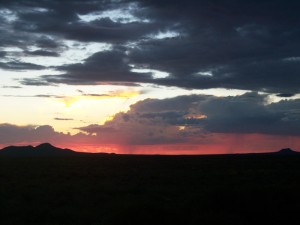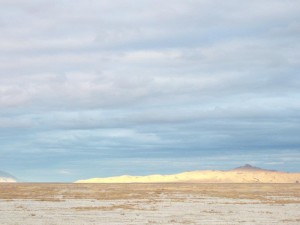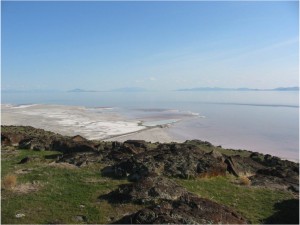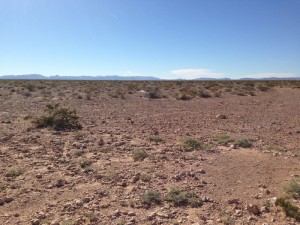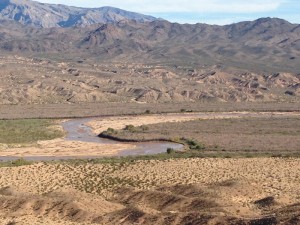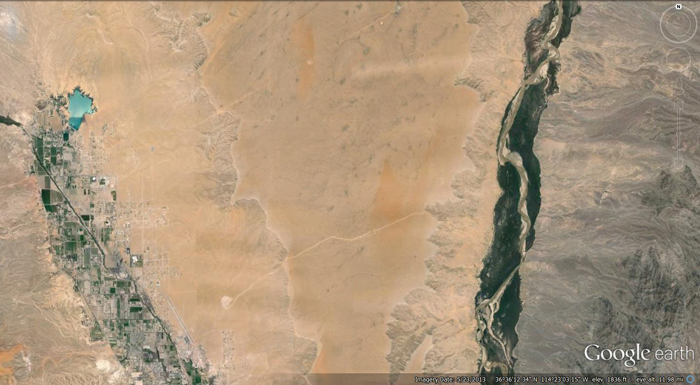
Regarding the View: Awe and Apprehension Encountered in Land Art Deserts by Hikmet Sidney Loe
In anticipation of visiting Michael Heizer’s 1969 earthwork “Double Negative” for the first time, I have done my research. The work is located on the Mormon Mesa north of Las Vegas near Overton, Nevada in a region that appears on Google Earth as an expansive, barren tabletop of red clay earth that falls away in the east into the Virgin River Valley (fig. 1). The approach to the earthwork is marked in this aerial view by a relatively straight road. At the site, two massive voids make up the 1,500-foot long work, where “running parallel to the mesa’s edge, the trenches face each other across one of the many scalloped-shaped erosions of the mesa’s escarpment.”(1) The psychological impact of the work is overwhelming: “Space becomes almost palpable, but also strangely elusive: from certain angles the gap between the trenches seems to collapse…This illusion, however, isn’t enough to dispel the almost sublime sense of isolation, the sense of aloneness that pervades the piece and affects anyone who visits it.”(2)
Descriptions of the landscape surrounding “Double Negative” echo how the American West is often described: vast, impenetrable, remote, forbidding, sublime. Artists engaged land as canvas in the 1960s and 1970s to carve, shape, and place monumental works of art. Landscapes—from those depicted in sixteenth-century paintings, to eighteenth-century sites of gardens and tourism, to twentieth-century Land art created in desert environs—reflect back to us designated, formed, and informed views. Within the expanse of the West’s terrain, local situations offer unique landscapes at Robert Smithson’s “Spiral Jetty” (1970), Nancy Holt’s “Sun Tunnels” (1973-76), and Walter De Maria’s “The Lightning Field” (1977). Each is situated in a topography known more for its forbidding nature than for its hospitable environment. Visiting Land art in these regions we each bring an individualized level of interest and inquiry. Beyond our knowledge of the work we carry our own aesthetic interests, an assimilation of learned cultural and historic understanding, and—we learn through emerging research—an evolutionary response to unique landscapes.
During the weeks of planning leading up to my visit to “Double Negative’s” desert environment, I found myself awed by Heizer’s vast undertaking but also apprehensive about crossing an unfamiliar landscape that offers little to no variation in view. Contemporary researchers have addressed this apprehension, stating that, “evolutionary imperatives might lay the groundwork for the human appreciation of certain landscapes.” (3) The Art Instinct: Beauty, Pleasure, & Human Evolution devotes an entire chapter to our perception of landscapes: “This fundamental attraction to certain types of landscapes is not socially constructed but is present in human nature as an inheritance from the Pleistocene, the 1.6 million years during which modern human beings evolved.” (4)
This research is certainly a new view towards understanding how we position ourselves in the topographical environment of Land art. My previous educational background in landscape history focused on the cultural and societal constructs devised that help mold our perception of space. While I am not ready to discard these views, I found the following statement—regarding our evolutionary orientation to landscape—resonated on a personal level: “Human beings are less attracted to absolutely open, flat grasslands and more toward a moderate degree of hilly undulation, suggesting a desire to attain vantage points for orientation.” (5) Drawing upon extensive research, the author shared one hypothesis claiming an attractive landscape: “whether it affords the ability to see without being seen. Human beings like a prospect from which they can survey a landscape, and at the same time they enjoy a sense of refuge.”(6) The drama of the landscape appears unquestionable. There is nothing like a desert vista of grand space ending as a precipice to generate a visceral physical and emotional response, and if this hypothesis is true, my apprehension in visiting “Double Negative” may be for naught as the work invites visitors to climb into its void spaces, offering refuge.
The basis of our sense of awe or apprehension experienced in large landscapes has fascinated me since first visiting the region of “Spiral Jetty” in 1996, an undertaking that took several trips before even finding Rozel Point and the submerged jetty. British artist Tacita Dean transformed her attempt to find the “Spiral Jetty” into her work “Trying to Find the Spiral Jetty” (1997), in which she chronicled her journey through the extraordinary terrain of northern Great Salt Lake on an audio recorder. The particular and peculiar qualities this locale encompasses is revealed in her recollection of the trek: “I can never be sure that I found the risen or submerged jetty…”(7)
The practicalities of the journey to Rozel Point came first. Then, as I studied the 1,500-foot long spiraled earthwork, various modes of philosophical and phenomenological thought began to shape how I viewed the landscape of Great Salt Lake, Utah. Smithson’s description of the region is found in his 1972 essay, which includes this hallucinatory passage: “As we traveled, the valley spread into an uncanny immensity unlike the other landscapes we had seen…slowly, we drew near to the lake, which resembled an impassive faint violet sheet held captive in a stony matrix, upon which the sun poured down its crushing light.”(8) (fig. 2)
Uncanny, impassive, crushing: these adjectives emphasize the sublime aspect of Great Salt Lake by characterizing a landscape of physical extremes. The eighteenth-century British philosopher Edmund Burke wrote of the emotions that can arise from such landscapes in his treatise differentiating the sublime from the beautiful: “The passion caused by the great and sublime in nature, when those causes operate most powerfully, is Astonishment; and astonishment is that state of the soul, in which all its motions are suspended, with some degree of horror. In this case the mind is so entirely filled with its object, that it cannot entertain any other, nor by consequence reason on that object which employs it.”(9)
When surrounded by the land of Rozel Point, the region’s cultural and geologic history doesn’t matter; all we regard is the view before us. The obvious monumental physicality embodied in the earthwork is matched by the land surrounding it, as is the case for each earthwork discussed. We are dependent on our own physical state and rely on our senses to comprehend that monumentality. Nancy Holt referenced the space around “Sun Tunnels” (1973-76) in Utah’s West desert by stating: “I wanted to bring the vast space of the desert back to human scale…the panoramic view of the landscape is too overwhelming to take in without visual reference points.”(10) (fig. 3) Holt placed four concrete tunnels in the flat, barren landscape of Utah’s western desert to provide those reference points for visitors.
Located in western New Mexico’s high desert region, Walter De Maria’s work “The Lightning Field” also employs reference points to orient the viewer. Comprised of 400 stainless steel posts erected in a grid-like pattern covering one kilometer by one mile, De Maria wrote, “the sum of the facts does not constitute the work or determine its aesthetics.”(11) Numbers do not equal experience, nor does the lack of lightning during a visit to the site diminish the experience of standing near the poles at sunset as the silver poles come alive with color and reflected light. (fig. 4)
Along with their shared location in the West’s desert regions, each Land artist invites visitors to experience their earthwork from the inside, providing a sense of refuge from the larger landscape. Being “inside” each work differs from site to site. “Double Negative’s” negative-spaced trenches invite exploration well below the mesa. The earthwork “Spiral Jetty” is a work completed by an essay and film, both of which include Smithson’s centralizing orientation: “From the center of the “Spiral Jetty”. North—Mud, salt crystals, rocks, water…” (12) “Sun Tunnels” afford a centered view, as Holt wrote: “From the center of the work, the tunnels extend the viewer visually into the landscape, opening up the perceived space.”(13) “The Lightning Field’s” center is found somewhere amidst its 400 poles, as the viewer determines the optimal vantage point to take in the work. Viewing “The Lightning Field” requires one to book the visit for a twenty-four hour period; visitors stay in a cabin at the site. The interior of the earthwork expands to include the interior space of a rustic retreat should one require a retreat from either landscape or lightning.
As the trip to “Double Negative” approaches, occasional questions interrupt practical trip planning: will we get lost? Will the weather be horrible? Will we encounter snakes? And the more subtle, but always nagging question: will the landscape overwhelm me as I stand on the top of Mormon Mesa, looking out at the flat space of seeming nothingness?(14) (fig. 5) Any assumptions and anxieties will soon dissipate as I stand above, next to, and in the work. Here is what I believe: I will love walking inside the work’s enclosed, negative space. The crumbling sides of its interior walls will speak of geologic strata; I will wear some of that earth home. It will be hot in the desert, even though it’s November. The feeling of the sun, the warmth of the ground, and the smell of the earth will mitigate the sharp pangs of anxiety I sometimes feel in unfamiliar, vast open spaces. I will have all or none of these experiences, as I have yet to embody the space of the work.
As I bring to the site art historical research, cultural expectations, and the new knowledge of our evolutionary propensities as we embody landscapes, I am reminded of the French philosopher Maurice Merleau-Ponty who wrote: “Visible and mobile, my body is a thing among things; it is caught in the fabric of the world, and its cohesion is that of a thing. But because it moves itself and sees, it holds things in a circle around itself.”(15) (fig. 6)
1 Howard Risatti, “Michael Heizer’s Double Negative,” Sculpture 22, no. 10 (December 2003), 18.
2 Ibid, 19.
3 G. Gabrielle Starr, Feeling Beauty: The Neuroscience of Aesthetic Experience (Cambridge: MIT Press, 27.
4 Denis Dutton, The Art Instinct: Beauty, Pleasure, & Human Evolution (New York: Bloomsbury Press, 2009), Kindle edition, chap. 1.
5 Ibid.
6 Ibid.
7 “Tacita Dean: Recent films and other works: Works: Trying to Find the Spiral Jetty 1997,” Tate, accessed November 3, 2014, http://www.tate.org.uk/whats-on/tate-modern/exhibition/tacita-dean-recent-films-and-other-works/tacita-dean-recent-films–3.
8 Robert Smithson, “The Spiral Jetty,” in Arts of the Environment, ed. Gyorgy Kepes (New York: George Braziller, 1972), 223.
9 Edmund Burke, A Philosophical Inquiry into the Origin of Our Ideas of the Sublime and the Beautiful, ed. Adam Phillips (Oxford: Oxford University Press, 2008), 53.
10 Nancy Holt, “Sun Tunnels,” Artforum 15, no. 8 (April 1977): 35.
11 Walter De Maria, “The Lightning Field,” Artforum 18, no. 8 (April 1980), 58.
12 Smithson, 227.
13 Holt, 35.
14 Having since completed the trip to “Double Negative”, I can answer this question with a resounding “yes.” The anxiety of getting lost (which we did), then finding the earthwork as the sun was setting heightened the sense that we were alone, literally on top of the world on that mesa.
15 Maurice Merleau-Ponty, “Eye and Mind,” in Art and Its Significance: An Anthology of Aesthetic Theory, 3d ed. ed. Stephen David Ross (Albany: State University of New York Press, 1994), 284.
Tags: Hikmet Sidney Loe, Journal